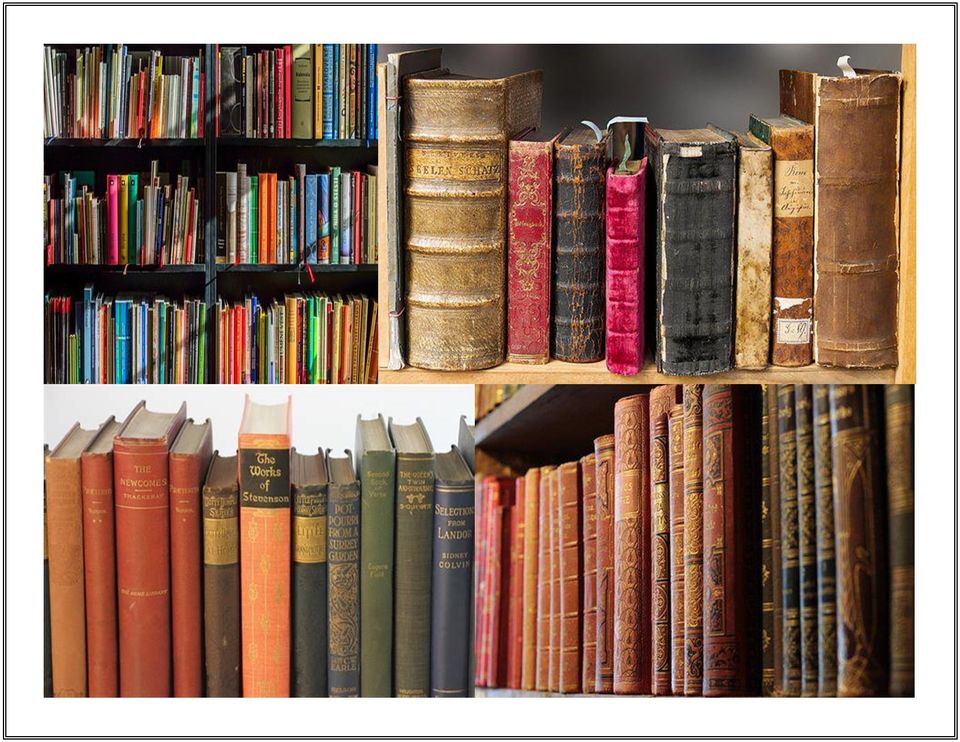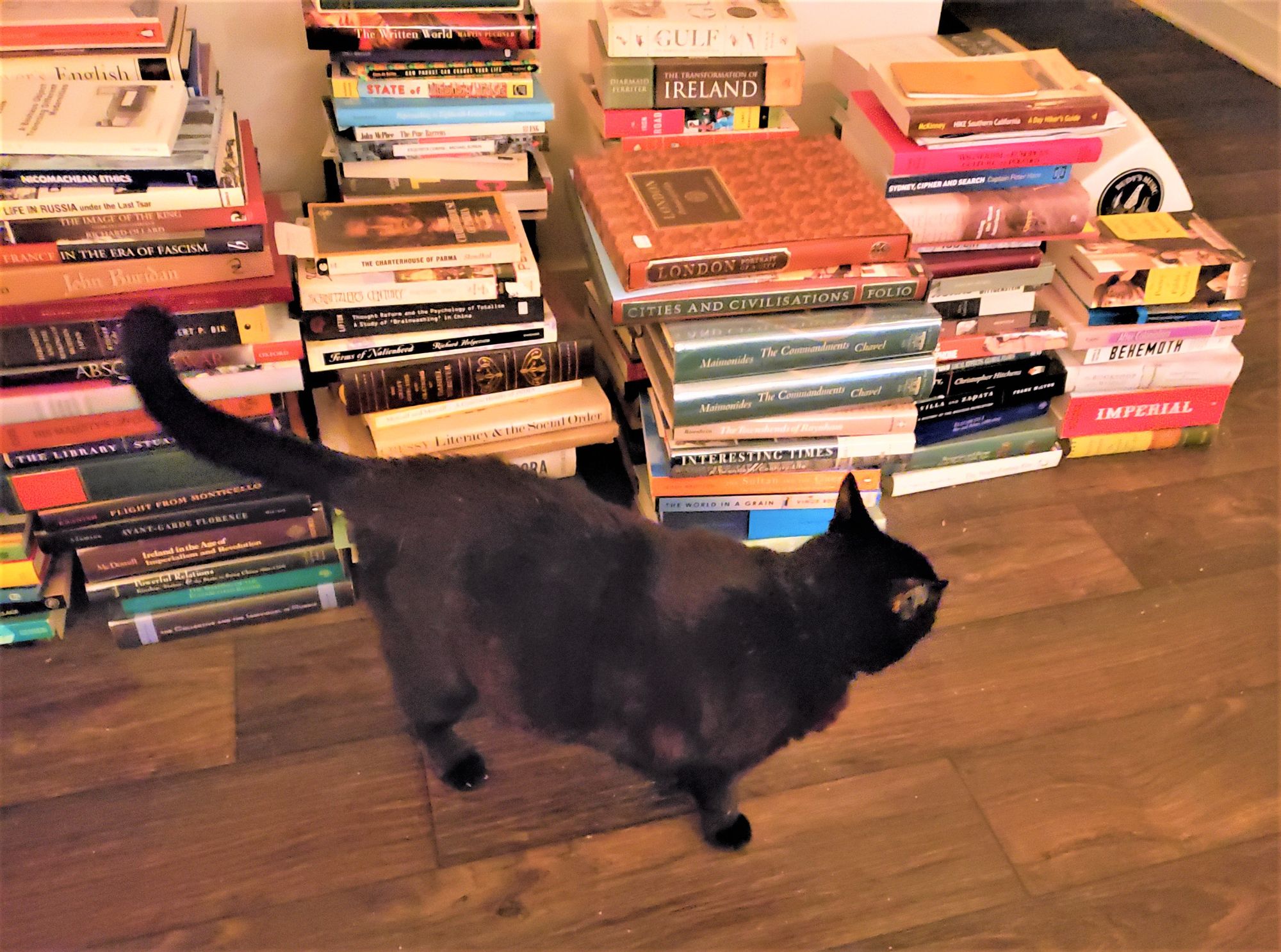Library Digressions: Curating the Chaos

Is it a library or simply a collection of books stacked for convenience in various parts of the house, frightening visitors, and threatening to engulf the cat in the middle of the night? I suppose the art of curation really makes all the difference, allowing you to call your volumes an institution in their own right and not just the fruit of pointless hoarding. So, establishing order for your literary life is of the utmost importance. Or is it? One could argue that disorganized bookstacks, and unstructured hours of reading, bring a host of wonderful rewards.
Random Journeys of the Mind
As numerous writers have discovered over the centuries, reading from one volume to the next, with no plan or objective, can yield riches of astounding magnitude. If I recall correctly, Montaigne simply called it “browsing” through his library and enjoyed the practice immensely. An idea that inspires you to begin a new endeavor, a subject that becomes your next research project, (perhaps lasting decades) or simply a random journey of the mind that makes you a better thinker, all of these can arise from a morning of reading, exploring one text and then another, a few pages here and there. Browsing is truly a joy.
To explore a collection of books — even by way of haphazard reading— is to investigate the world, an activity of excitement that simultaneously invites repose and quiet reflection. Yes, there is something inherently peaceful and exciting about literary life as it unfolds in this manner. These thoughts accompany me as I sip coffee and turn pages with no particular plan in mind, apart from making a trip to the bookstore. Ah, the bookstore! Once we depart the familiar spaces of our own library, and begin to seek new acquisitions, yet another dimension of book life is revealed.
Library digressions often lead to shopping and mingling with fellow bibliophiles, which is all the more fun while traveling. As we all know, happening upon a reading room or a quaint shop — possibly historic and much beloved — is another enriching aspect of the journey.
The moment one visits a new city and locates a bookstore, everything changes; a well-planned day transforms into a spontaneous expedition through stacks of hidden treasure, where dust and the fragrance of old paper attend every step, an experience of sheer delight. Over the years, I’ve found myself remembering cities for the shops they host: City Lights Bookstore in San Francisco, The Strand in New York, Elliott Bay Book Company in Seattle, and Vroman’s Bookstore in Pasadena, California rank among my favorites. What are some of yours? Of course, discovering a new enclave of literary life brings certain complications; upon entering one of these glorious places, difficult questions arise.
Will you spend additional money shipping books to your house, because they won’t fit into your suitcase? Do you actually have room for more stacks? Will your long-suffering spouse be willing to sign for yet another shipment of books — for which you have no room? The joy of acquisition is accompanied by practical concerns.

Where Will the Books Go?
It’s a common problem; the bookcases that grace the living room — and once seemed sufficient to the task — have begun to overflow. Running out of room is something of an occupational hazard for a researcher. Most of my Ikea bookcases, with their sturdy particle board shelves, are forced to endure multiple layers of books, probably several times the capacity they were intended to manage, sometimes with disastrous consequences, but I digress.
What began as an orderly creation — a gathering of books curated for ease of research — has, over long decades, grown into unorganized stacks, hundreds of volumes occupying alcoves and filling the corners of my office. Looking back, I can say that my books originally assembled themselves neatly, with little prompting from me, and cohabitated as an actual library. However, they eventually became an unruly mob when I was not looking. Perhaps you can relate.
Years ago, I had a supervisor whose mother was a rare book dealer. I told her about my stacks of books and their tendency to multiply (almost without notice) and flow into every space imaginable. She told me not to worry. “My mom has bookcases in all her bathrooms. Just don’t do that.” Duly noted.
The Challenges of Retrieval
The other night, while planning this article, I remembered a book I wanted to reference and share with you, a fascinating study on libraries and archives. Then, I wondered how long it would take to locate. And herein lies the secret of management: if you can recall where you last saw a certain book, and retain a mental image of its surroundings, you can find it at a moment’s notice, at least in theory.
Full disclosure: it took about an hour, but I did manage to locate the volume in question, as it lingered in the shadow of Victorian Conventions by John R. Reed. I have no idea why I placed it there. However, upon recognizing the distinctive dust jacket, I felt a sense of exhilaration and continued my research by studying a book I greatly admire.
Fantasies of the Library is a groundbreaking work, containing essays on theory, as well as critical examinations of book-related art installations. In addition, the editors chose to incorporate curatorial dialogues into the narrative, creating a richly layered text.
“Additional reflections on the role of cultural memory and the archive are unfolded throughout our conversation with Hammad Nasar from the Asia Art Archive.” (1)
The volume is named for Michel Foucault’s piece “Fantasia of the Library,” wherein protagonist Gustave Flaubert re-composes previous records, including paintings and books, in order to create his own writings. (2) This kind of research is truly fascinating and fits well with my current interests. At the moment, I am curious about the reading methods that support personal essay development.
New ideas are like characters waiting to tell their story.
Overall, it’s about flipping pages of text and examining fragments of themes and images, unrelated elements that stimulate contemplation. This is my favorite research method, persistently sifting through ages of thought and discourse, engaging the best minds of history, a few pages here, a few sentences there. The resulting discoveries can become their own dramatic narrative.
To some extent, the ideas and images you encounter in various books are akin to literary characters, players who reveal their relationships as you begin to write their story. For poets, personal essayists, and experimental prose writers, this method of re-contextualizing ideas — as if they were characters waiting for development and their own storylines — is quite useful. So, how can we build on this concept? Just for fun, let’s take a moment to digress and reiterate, exploring the process in a bit more detail.
Research Methods (without Method)
Spontaneous (disorganized) reading expeditions help us to generate themes intuitively, in ways which cannot be predicted or even fathomed. You simply wander through a library, reading any text you choose, harvesting an array of ideas, feeding your imagination. This is how I envision the practice of reading in order to write; it serves as a joyful romp through ages of thought and imaginings, each page of text — each word, really — leading to inspiration. Needless to say, I will return to Fantasies of the Library in future articles to explore its riches more fully. Now, I’ll conclude with a few final thoughts about my library, that ever-growing communion of ideas.
My collection of books can transform suddenly, morphing from an organized library into a chaotic amalgam of titles and subjects without warning. Regardless of how often I attempt to impose order, the collection prefers to remain unruly. However, the books do seem to maintain an interesting connection, each volume lending a sort of context to its companions.
Curating the Chaos: An Endless Dialogue
The process of building a community of books is fun, exciting, and vaguely dialectical, I suppose, as one narrative gives rise to countless others, the works arranging themselves for incredible dialogues, perhaps a bit Talmudic in nature. After a certain point, the writing process becomes an exercise in listening, as the books reveal themselves and tell their stories.
As for the size of my collection, a few cat sitters and ex-girlfriends have made off with volumes over the years, so it has trimmed-down a bit. In no particular order, some of the general headings include:
· World History
· Art History
· Music Theory
· The Performing Arts
· Architecture (Western)
· Literary Theory
· Urban Planning (American)
· Poetry
· Essays
· Nature Writing
· Jewish Studies
· Museum Studies
· The American Civil War
With some success, I’ve used Library Thing and Tiny Cat for cataloging. If you have any suggestions about organizing a home library, please let me know! As always, I thank you for reading and commenting. Cheers!
References:
(1) Fantasies of the Library. Edited by Anna-Sophie Springer & Etienne Turpin. (Cambridge, MA: The MIT Press, 2016). (p. v).
(2) ibid. (pgs. 31–33).
For Further Reading:
The Oxford Book of Essays. Chosen and Edited by John Gross. (Oxford, New York: Oxford University Press, 1991).
Additional Notes on Research:
There is a staggering amount of information available to us now, the lines between primary and secondary sources often becoming fluid and difficult to discern. In addition, new formats for citing digital sources are always emerging. With that in mind, I have found The Craft of Research by Wayne C. Booth, Gregory G. Colomb and Joseph M. Williams to be extremely helpful.